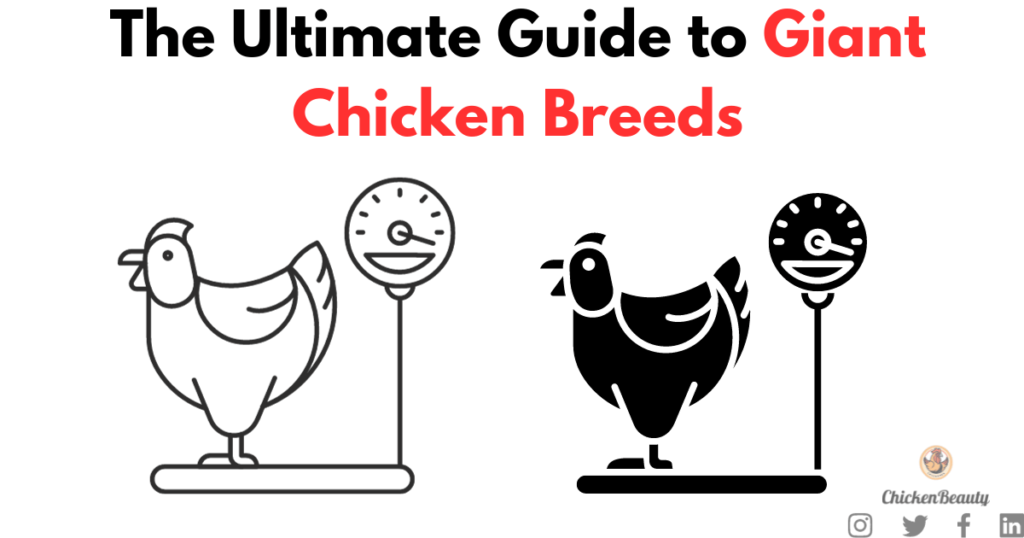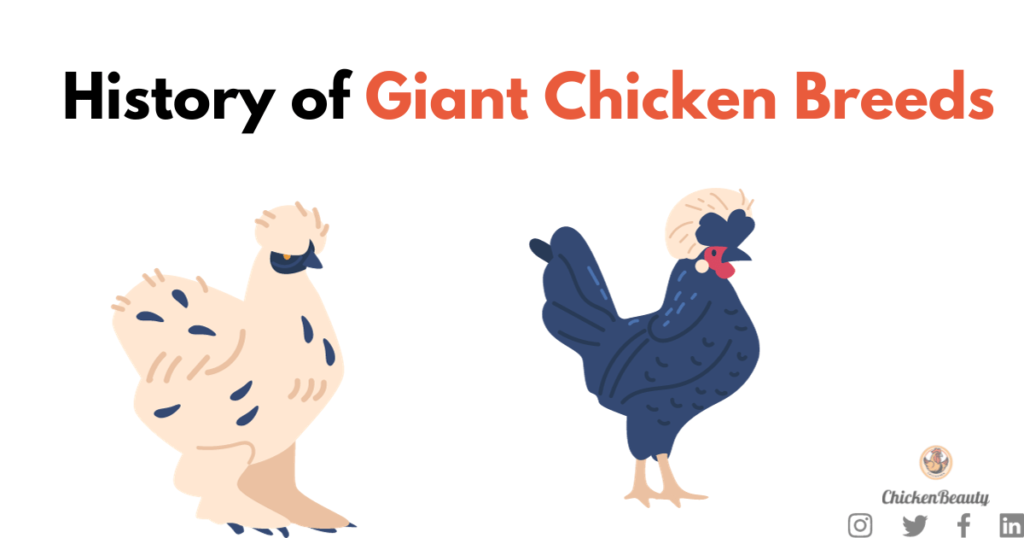giant chicken breeds – If you’ve ever dreamed of having a feathered friend that could double as a velociraptor stunt double, then you’re in for a clucking good time! Today, we’re diving beak-first into the egg-citing world of giant chicken breeds. These colossal cluckers will leave you egg-claiming with amazement. Bawk, bawk, and away!

What Makes a Chicken “Giant”?
Giant chicken breeds are not your average backyard chickens. They are distinguished by their significantly larger size compared to standard chicken breeds. While standard chickens generally weigh between 5 to 8 pounds, giant chicken breeds can weigh anywhere from 10 to 18 pounds or even more, depending on the specific breed. This remarkable size difference is a result of selective breeding over many generations.
Before we take a peck at some of these larger-than-life birds, let’s feather out what makes a chicken a bona fide giant. Giant chicken breeds are known for their egg-traordinary size, weighing in at a plump and poultry licious 10 pounds or more. These behemoth birds strut around like they own the coop, and they sure do make an excellent conversation starter!
Popular Giant Chicken Breeds
The Brahma: A Gentle Giant
The Brahma chicken, also known as the “King of Chickens,” is a true feathered giant. These hefty hens can tip the scales at a whopping 12 pounds! With their feathery legs and fluffy plumage, Brahmas are the gentle giants of the chicken world. They’re as friendly as they are big, making them a favourite among poultry enthusiasts.
Eggspert Tip: Brahmas might be big, but they’re not exactly the Usain Bolt of the chicken world. Don’t be surprised if you catch them waddling rather than sprinting!
The Jersey Giant: Not Just a Name
Meet the Jersey Giant, a chicken breed that sounds like it could wrestle cows on the weekends. These colossal chickens can reach a whopping 15 pounds or more! They’re known for their striking black plumage and friendly disposition. If you’re looking for a giant buddy that’s as cool as a cucumber, the Jersey Giant is your pick.
Eggspert Tip: Jersey Giants are known to be gentle giants, but their size can sometimes lead to clumsy moments. Be ready for the occasional awkward chicken dance!
The Cochin: Fluffiness Galore
If you thought chickens couldn’t get fluffier than a marshmallow, think again! The Cochin chicken might not be the biggest giant on the block, but they make up for it in sheer fluffiness. These fluffy balls of feathers can weigh around 8 to 11 pounds. With their charming feathered feet and sweet temperament, Cochins are the teddy bears of the poultry world.
Eggspert Tip: Keep in mind that those feathery feet are a magnet for dirt, so be prepared for a bit of extra grooming to keep your Cochin looking fabulous!
The Orpington: A British Gentle Giant
Originating from the UK, the Orpington chicken is another giant breed worth clucking about. These plump poultry pals can weigh between 8 to 10 pounds. They come in various delightful colours, from buff to blue. Orpingtons are known for their friendly nature and are often described as the “lap chickens” of the giant chicken world.
Eggspert Tip: Orpingtons are known to be foodies. Don’t be surprised if they follow you around the yard, hoping for a snack. Who can blame them?

History of Giant Chicken Breeds
Here’s a brief overview of the development of giant chicken breeds:
Early Origins: The concept of selectively breeding chickens for larger sizes can be traced back to ancient times. People have been raising chickens for thousands of years for their meat and eggs. In some cultures, larger chickens were preferred for feasts and special occasions.
Development of Specific Breeds:
Dorking: One of the earliest known giant chicken breeds, the Dorking, originated in England during Roman times. It was renowned for its meat quality and size.
Brahma: The Brahma chicken, developed in the United States in the mid-1800s, played a significant role in the development of giant chicken breeds. It was created by crossing various large Asian breeds, including the Malay and Cochin. The Brahma’s size and distinctive appearance made it popular.
Cochin: The Cochin chicken, originating from China, was another influential giant breed. It was introduced to the West in the mid-1800s and quickly gained popularity for its size and unique feathering.
Jersey Giant: This breed was developed in the late 1800s in the United States. It was specifically bred to be a giant meat chicken and remains one of the largest chicken breeds to this day.
Selective Breeding: As poultry breeding techniques advanced, breeders began to select larger and heavier individuals within specific breeds. This led to the development of larger strains of existing breeds.
Modern Giant Chicken Breeds: Today, various giant chicken breeds exist, including the Jersey Giant, Brahma, Cochin, and Langshan. These breeds are prized for their size, meat quality, and sometimes their ornamental value in backyard flocks.
Challenges: While giant chicken breeds offer advantages in terms of meat production, they also face challenges. Their large size can make them less efficient at converting feed to meat compared to smaller, commercial breeds. Additionally, they may require more space and care due to their size.

ALSO READ 👇
The Craziest Weird Chicken Breeds 2023
Unlock the Hidden Power of Chicken Feet Health Benefits
Feathered Foodies: Can Chickens Eat Carrot Tops?
How Long do Chickens Sleep? The Surprising Truth
Fluffy Chicken Breeds: Where Cuteness Meets Feathers
The Ultimate Guide to Building Chicken Breeding Pens for Maximum Efficiency
Caring for Giant Chickens
Here are some essential guidelines for caring for these impressive birds:
Housing:
Provide a spacious and secure coop with at least 4-5 square feet of space per bird to prevent overcrowding.
Ensure the coop is well-ventilated, dry, and draft-free, as damp conditions can lead to health issues.
Feeding:
Giant chickens require a balanced diet rich in protein and nutrients. Use commercial poultry feed designed for large breeds.
Supplement their diet with fresh vegetables, fruits, and grains to provide variety and additional nutrients.
Ensure access to clean, fresh water at all times.
Healthcare:
Regularly check your chickens for signs of illness, injury, or parasites. Treat any issues promptly.
Vaccinate your chickens as recommended by a veterinarian to prevent common diseases.
Trim their toenails and beak as needed to prevent overgrowth.
Exercise and Space:
Large chickens need ample space to move around. Allow them access to a secure outdoor run during the day.
Provide perches inside the coop at varying heights to encourage exercise and prevent muscle atrophy.
Protection from Predators:
Ensure the coop and outdoor run are secure to protect your giant chickens from predators such as foxes, raccoons, and birds of prey.
Lock them safely inside the coop at night to prevent nighttime attacks.
Egg Production:
Expect lower egg production from giant breeds compared to smaller breeds. They may lay larger eggs but less frequently.
Provide comfortable nesting boxes with clean bedding for egg-laying.
Social Interaction:
Giant chickens can be sociable and enjoy interaction with their owners. Spend time with them to keep them tame and happy.
Grooming:
Regularly check and clean their feathers to prevent mites and lice infestations.
Dust-bathing areas can help chickens maintain their plumage.
Breeding Considerations:
If you plan to breed giant chickens, be mindful of the size of the roosters, as their weight can cause injury to hens during mating.
Monitor Growth:
Keep an eye on the growth of your giant chickens. They grow rapidly and may need different feeding and care requirements as they mature.
Conclusion Giant Chicken Breeds
Giant chicken breeds bring a whole new meaning to the phrase “big bird.” From the gentle Brahmas to the fluffy Cochins, these colossal cluckers will leave you in awe of their extraordinary size and charm. So, whether you’re looking for a friendly feathered companion or just want to impress your friends with a chicken the size of a small dog, giant chicken breeds have you covered. Happy clucking!
In the world of chickens, bigger is funnier!
FAQs Giant Chicken Breeds
1. Are giant chicken breeds suitable for beginners in poultry farming?
Yes, many giant chicken breeds are well-suited for beginners due to their calm temperament and ease of care.
2. Can giant chickens be kept in urban environments?
While it’s possible to keep giant chickens in urban areas, you must ensure you have enough space and comply with local regulations regarding livestock.
3. What is the average lifespan of giant chicken breeds?
Giant chickens can live an average of 6 to 8 years with proper care.
4. Are giant chicken breeds good for both meat and egg production?
Yes, many giant chicken breeds are dual-purpose and can provide both large eggs and meat, making them valuable for self-sufficiency in food production.

